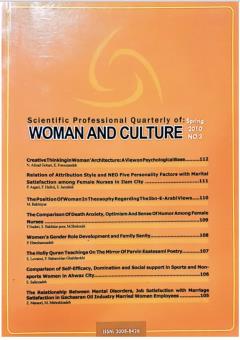Creative Thinking in Woman’ Architecture: A View on Psychological Base
Subject Areas : Moralityنغمه Alizad Gohari 1 , الهام Foroozandeh 2
1 - Assistant Professor in Architecture in Islamic Azad University (Naein Branch)
2 - Assistant Professor in Architecture in Islamic Azad University (Naein Branch)
Keywords:
Abstract :
Undoubtedly one of the most important elements of designing and constructing permanent structures, salient and unique buildings is based on creativity. Creative thinking is one of the most complex and highest manifestations of human thought that leads to the uniqe architecture buldings. Since classical architecture view includes three areas named as strength, utility and aesthetics (structure, function, form); creativity can appears in all of these three layers. For example, sometimes the architectural structure occurs as the most innovative work, such as Calatrava’s works; and sometimes form may appear as the first and most important factor, such as Gehry and Le Corbusier’s works. Also creative thinking can play a considerable role in case of function, for example sophasticated airports plans can end to complex problems optimized resolving. These three factors can be also seen in a single project. Although a great deal of psychological studies examine and emphasis on gender differences in general and particulary in creativity, this paper was written about different aspects of creativity in architecture.Finally with regard to the psychological findings, creativity in women’s designs was discussed and creative examples of projects which presented by women -with a focus on Zaha Hadid – were introduced.
آنتونیادس، آنتونی سی،" بوطیقای معماری"، ترجمه احمدرضا آی(1381) چاپ اول، انتشارات سروش، تهران.
افشار نادری، کامران(1379) "تکنیک های خلاقیت"، مجله معمار، شماره ۹، ص۴ تا ۱۲، تهران.
بولن، شینودا،"نمادهای اسطورهای و روانشناسی"، ترجمه آذریوسفی(1384) چاپ سوم، نشر روشنگران، تهران.
خورشیدی، عباس؛ میرکمالی، محمد(1387)،"روش های پرورش خلاقیت"، چاپ اول، نشر یسطرون، تهران.
گاوین، شاکتی، "تجسم خلاق"، ترجمه گیتی خوشدل(1369) چاپ سوم، انتشارات همراه، تهران.
قاسم زاده، حسن؛ حسینی، افضل السادات؛ میر قیداری، مجتبی" نشست خلاقیت"، نقل از گلشنی، ایرج(1383)، مجله علوم و فنون، شماره 78، تهران.
"تکنیک های خلاقیت"، بهار 1381، فصلنامه رایانه، معماری و ساختمان ، تهران.
توی،مگی، "معماری زنانه و زنان معمار"، ترجمه مینا مهدلو(1388) چاپ اول، انتشارات یزدا، تهران.
Baer, J. (1999). Gender differences. In M. A. Runco & S. Pritzker (Eds.). Encyclopedia of creativity (Vol. 1,pp. 753–758). San Diego: Academic Press.
Baer, J. (2005). Gender and creativity. Paper presented at the Annual Meeting of the American Psychological Association, Washington, DC (August).
Eysenck, H. J. (1995). Genius. The natural history of creativity. Cambridge: Cambridge University Press.
Kershner, J. R., & Ledger, G. (1985). Effect of sex, intelligence, and style of thinking on creativity: A comparison of gifted and average IQ children. Journal of Personality and Social Psychology, 48, 1033–1040.
Lorenz,c. (1990).Women in Architecture: A contemporary perspective. London: Trefoil publications Ltd.
Reiss, S. M. (1999). Women and creativity. In M. A. Runco & S. Pritzker (Eds.). Encyclopedia of creativity (Vol. 2,pp. 699–708). San Diego: Academic Press.
Runco, M. A. (2004). Everyone has creative potential. In R. J. Sternberg, E. L. Grigorenko, & J. L. Singer (Eds.),Creativity: From potential to realization (pp. 21–30). Washington, DC: American Psychological Association.
Simonton, D. K. (1992). Gender and genius in Japan: Feminine eminence in masculine culture. Sex Roles, 27, 101–119.
Simonton, D. K. (2000). Creativity. Cognitive, personal, developmental, and social aspects. American Psychologist, 55,151–158.
http://www.zanan.co.ir
http://www.memarblog.com
http://www.magiran.com/magtoc.asp?
_||_

